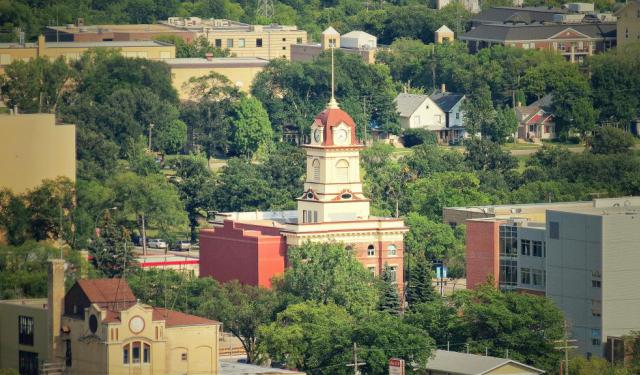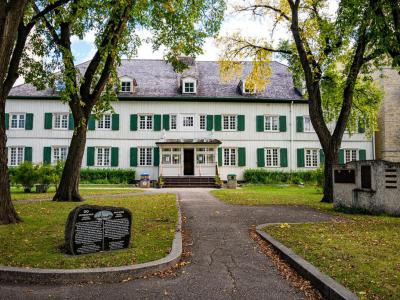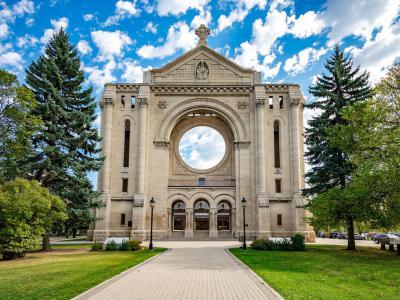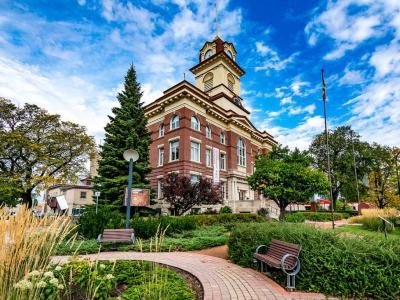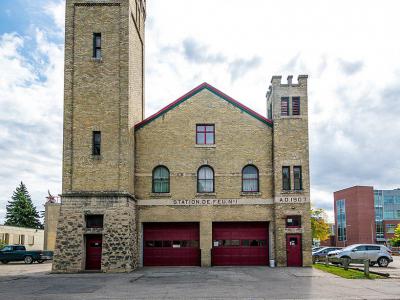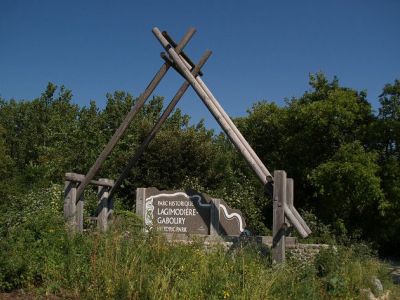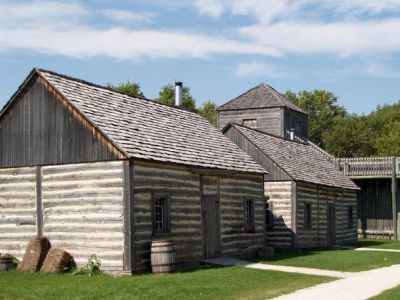Saint Boniface Walking Tour (Self Guided), Winnipeg
"In the heart of Winnipeg, where the river flows and the spirit of voyageurs still dances in the air, the soul of French-Canadian culture beats in Saint Boniface."
Before the European settlers arrived, the area on the east bank of the Red River was inhabited by the indigenous First Nations people. In 1818, a French-Canadian clergyman named Joseph-Norbert Provencher, one of the founders of the modern province of Manitoba, established a Roman Catholic mission on the site, which later grew into the community of Saint Boniface.
The area was named after the missionary saint, who played a significant role in the Christianization of Europe and has been historically associated with the Francophone community in Winnipeg. For this reason, it is often referred to as the "French Quarter".
The neighborhood's principal symbol is the Saint Boniface Cathedral. The current structure, known as the "new" Saint Boniface Cathedral, was completed in 1972 after the original cathedral was destroyed by fire four years earlier. Another prominent attraction, located nearby, is the Saint Boniface Museum – it showcases the history and cultural heritage of the district and the local Francophone community.
Two more landmarks, also named for the same saint, the St Boniface City Hall and St Boniface Fire Hall are distinctive pieces of French-Canadian architecture and significantly contribute to the historical and cultural fabric of the quarter.
The pedestrian Esplanade Riel bridge spanning the Red River, connecting downtown Winnipeg with Saint Boniface lying directly across, is yet another notable architectural landmark. Modern in its design, it offers a picturesque view of the cityscape and is home to a popular restaurant called "Salisbury House," renowned for its iconic Winnipeg-style hamburgers.
A living testament to the fusion of French and Indigenous cultures, “where traditions merge and the pulse of Franco-Manitoban vitality reverberates through the streets," the historic Saint Boniface neighborhood is a cherished part of Winnipeg's identity. If you wish to capture the essence of this quarter and get enchanted by the aura of joie de vivre (joy of living) that it exudes, take our self-guided walk.
Before the European settlers arrived, the area on the east bank of the Red River was inhabited by the indigenous First Nations people. In 1818, a French-Canadian clergyman named Joseph-Norbert Provencher, one of the founders of the modern province of Manitoba, established a Roman Catholic mission on the site, which later grew into the community of Saint Boniface.
The area was named after the missionary saint, who played a significant role in the Christianization of Europe and has been historically associated with the Francophone community in Winnipeg. For this reason, it is often referred to as the "French Quarter".
The neighborhood's principal symbol is the Saint Boniface Cathedral. The current structure, known as the "new" Saint Boniface Cathedral, was completed in 1972 after the original cathedral was destroyed by fire four years earlier. Another prominent attraction, located nearby, is the Saint Boniface Museum – it showcases the history and cultural heritage of the district and the local Francophone community.
Two more landmarks, also named for the same saint, the St Boniface City Hall and St Boniface Fire Hall are distinctive pieces of French-Canadian architecture and significantly contribute to the historical and cultural fabric of the quarter.
The pedestrian Esplanade Riel bridge spanning the Red River, connecting downtown Winnipeg with Saint Boniface lying directly across, is yet another notable architectural landmark. Modern in its design, it offers a picturesque view of the cityscape and is home to a popular restaurant called "Salisbury House," renowned for its iconic Winnipeg-style hamburgers.
A living testament to the fusion of French and Indigenous cultures, “where traditions merge and the pulse of Franco-Manitoban vitality reverberates through the streets," the historic Saint Boniface neighborhood is a cherished part of Winnipeg's identity. If you wish to capture the essence of this quarter and get enchanted by the aura of joie de vivre (joy of living) that it exudes, take our self-guided walk.
How it works: Download the app "GPSmyCity: Walks in 1K+ Cities" from Apple App Store or Google Play Store to your mobile phone or tablet. The app turns your mobile device into a personal tour guide and its built-in GPS navigation functions guide you from one tour stop to next. The app works offline, so no data plan is needed when traveling abroad.
Saint Boniface Walking Tour Map
Guide Name: Saint Boniface Walking Tour
Guide Location: Canada » Winnipeg (See other walking tours in Winnipeg)
Guide Type: Self-guided Walking Tour (Sightseeing)
# of Attractions: 7
Tour Duration: 2 Hour(s)
Travel Distance: 4.6 Km or 2.9 Miles
Author: DanaOffice
Sight(s) Featured in This Guide:
Guide Location: Canada » Winnipeg (See other walking tours in Winnipeg)
Guide Type: Self-guided Walking Tour (Sightseeing)
# of Attractions: 7
Tour Duration: 2 Hour(s)
Travel Distance: 4.6 Km or 2.9 Miles
Author: DanaOffice
Sight(s) Featured in This Guide:
- St. Boniface Museum
- St. Boniface Cathedral
- Esplanade Riel
- St. Boniface City Hall
- St. Boniface Fire Hall
- Lagimodiere Gaboury Historic Park
- Fort Gibraltar
1) St. Boniface Museum
The Saint Boniface Museum is a significant cultural institution located in Winnipeg. The museum is dedicated to showcasing the rich history and heritage of the Franco-Manitoban and Métis communities. It is housed in the oldest building in Winnipeg, which holds a fascinating historical legacy of its own.
Originally constructed as a convent, the building was initiated in 1846 and completed in 1851 under the guidance of the Grey Sisters. Over the years, this historic structure has served multiple purposes, including an orphanage, a school, a seniors' home, and the first Saint Boniface Hospital. The museum stands as a testament to the many lives and stories that have been woven within its walls.
The construction of the building reflects the traditional Red River method, commonly known as mortise and tenon or tongue and groove. This technique involves joining wooden pieces without the use of nails, showcasing the skill and craftsmanship of the builders.
The Saint Boniface Museum holds the distinction of being designated a National Historic Site of Canada in 1958, a testament to its architectural and cultural importance. It serves as a repository of invaluable artifacts and exhibits that celebrate the life and legacy of Louis Riel, a key figure in Métis and Canadian history.
Visitors to the museum can view various personal belongings of Riel, including the locks of his hair, his revolver, his shaving kit, and his moccasins. Additionally, poignant reminders of his tragic fate are on display, such as pieces of the rope used during his hanging, the white hood placed upon him before his execution, and the coffin that cradled his body afterward.
Originally constructed as a convent, the building was initiated in 1846 and completed in 1851 under the guidance of the Grey Sisters. Over the years, this historic structure has served multiple purposes, including an orphanage, a school, a seniors' home, and the first Saint Boniface Hospital. The museum stands as a testament to the many lives and stories that have been woven within its walls.
The construction of the building reflects the traditional Red River method, commonly known as mortise and tenon or tongue and groove. This technique involves joining wooden pieces without the use of nails, showcasing the skill and craftsmanship of the builders.
The Saint Boniface Museum holds the distinction of being designated a National Historic Site of Canada in 1958, a testament to its architectural and cultural importance. It serves as a repository of invaluable artifacts and exhibits that celebrate the life and legacy of Louis Riel, a key figure in Métis and Canadian history.
Visitors to the museum can view various personal belongings of Riel, including the locks of his hair, his revolver, his shaving kit, and his moccasins. Additionally, poignant reminders of his tragic fate are on display, such as pieces of the rope used during his hanging, the white hood placed upon him before his execution, and the coffin that cradled his body afterward.
2) St. Boniface Cathedral
Saint Boniface Cathedral, located in the heart of Winnipeg, is a significant Roman Catholic landmark and serves as the principal church in the Roman Catholic Archdiocese of Saint Boniface. It holds great importance to the local community, particularly the Franco-Manitoban population. Before a devastating fire in 1968, the church held the status of a minor basilica.
Situated along the banks of the scenic Red River, the cathedral offers a picturesque view of its surroundings. In Verendrye Park, adjacent to the cathedral, stands a statue of Pierre La Vérendrye, created by the artist Joseph-Émile Brunet. Across the river lies The Forks, a popular destination in Downtown Winnipeg.
Saint Boniface Cathedral's history dates back to 1818 when Reverend Norbert Provencher and colleagues built the first church on land donated by Thomas Douglas, the 5th Earl of Selkirk. This initial log building served as a chapel, residence, and school, later replaced by a larger structure.
Between 1888 and 1906, the Catholic population in Saint Boniface grew, mostly consisting of French heritage. As a result, a larger cathedral was needed. Contractors Senecal and Smith built the new cathedral based on architect Jean-Omer Marchand's plans. Monsignor Louis-Philippe Adélard Langevin dedicated the impressive newly constructed cathedral on August 15, 1906.
On July 22, 1968, a fire destroyed the 1906 cathedral, including the rose window, vestments, bells from 1860, and parish records. Only the facade, sacristy, and parts of the old church's walls survived. In 1972, a new cathedral designed by Gaboury and Lussier was built, blending old and modern architecture.
Situated along the banks of the scenic Red River, the cathedral offers a picturesque view of its surroundings. In Verendrye Park, adjacent to the cathedral, stands a statue of Pierre La Vérendrye, created by the artist Joseph-Émile Brunet. Across the river lies The Forks, a popular destination in Downtown Winnipeg.
Saint Boniface Cathedral's history dates back to 1818 when Reverend Norbert Provencher and colleagues built the first church on land donated by Thomas Douglas, the 5th Earl of Selkirk. This initial log building served as a chapel, residence, and school, later replaced by a larger structure.
Between 1888 and 1906, the Catholic population in Saint Boniface grew, mostly consisting of French heritage. As a result, a larger cathedral was needed. Contractors Senecal and Smith built the new cathedral based on architect Jean-Omer Marchand's plans. Monsignor Louis-Philippe Adélard Langevin dedicated the impressive newly constructed cathedral on August 15, 1906.
On July 22, 1968, a fire destroyed the 1906 cathedral, including the rose window, vestments, bells from 1860, and parish records. Only the facade, sacristy, and parts of the old church's walls survived. In 1972, a new cathedral designed by Gaboury and Lussier was built, blending old and modern architecture.
3) Esplanade Riel
Esplanade Riel is a remarkable pedestrian bridge that spans the Red River, connecting downtown Winnipeg with the vibrant neighborhood of Saint Boniface in Manitoba. This iconic bridge holds significant historical and architectural value and was named in honor of Louis Riel, a prominent figure in Canadian history.
Designed by architects Guy Prefontaine and Etienne Gaboury, Esplanade Riel features a unique side-spar cable-stayed design. The bridge is complemented by its counterpart, the Provencher Bridge, which is a vehicular bridge situated nearby. The highlight of Esplanade Riel is its stunning architectural composite tower, which is prestressed and boasts a cantilevered and stayed semi-circular plaza area at its base. This plaza serves as a versatile space for commercial activities and houses a distinctive restaurant.
Additionally, new roadways and sidewalks were developed to connect the bridges to Downtown Winnipeg and Waterfront Drive, facilitating smoother traffic flow and improving accessibility in the area.
Esplanade Riel continues to be a beloved attraction and a bustling pedestrian thoroughfare, offering breathtaking views of the Red River and the surrounding landscape. With its rich history, an architectural marvel, and the enduring allure of its restaurant concept, Esplanade Riel remains a cherished landmark that embodies the spirit of Winnipeg and its dedication to blending tradition with modernity.
Designed by architects Guy Prefontaine and Etienne Gaboury, Esplanade Riel features a unique side-spar cable-stayed design. The bridge is complemented by its counterpart, the Provencher Bridge, which is a vehicular bridge situated nearby. The highlight of Esplanade Riel is its stunning architectural composite tower, which is prestressed and boasts a cantilevered and stayed semi-circular plaza area at its base. This plaza serves as a versatile space for commercial activities and houses a distinctive restaurant.
Additionally, new roadways and sidewalks were developed to connect the bridges to Downtown Winnipeg and Waterfront Drive, facilitating smoother traffic flow and improving accessibility in the area.
Esplanade Riel continues to be a beloved attraction and a bustling pedestrian thoroughfare, offering breathtaking views of the Red River and the surrounding landscape. With its rich history, an architectural marvel, and the enduring allure of its restaurant concept, Esplanade Riel remains a cherished landmark that embodies the spirit of Winnipeg and its dedication to blending tradition with modernity.
4) St. Boniface City Hall
Saint Boniface City Hall, located in Winnipeg, stands as a testament to the rich history and development of the Saint Boniface community. Constructed between 1905 and 1906, this impressive three-story red brick structure has been an integral part of the cityscape for over a century. Nestled in a prominent position near other municipal facilities, Saint Boniface City Hall showcases a classic Georgian Revival-style design with intricate classical details.
Saint Boniface City Hall was built when the area was an independent French community. Its construction was necessary due to the growing population and economy. Renowned architect Victor Horwood designed the building on the main street for easy access and to highlight its significance.
Saint Boniface City Hall impresses visitors with its historically significant spaces. The main floor houses the council chamber, where crucial decisions are made. The second floor has functional offices for administrative tasks. A grand stairway connects the basement to the third floor, adding elegance to the building.
One of the distinctive features of Saint Boniface City Hall is its tower, which acts as a visual landmark for the community. The tower not only adds to the building's architectural charm but also symbolizes the unity and pride of the Saint Boniface residents. Over the years, it has become a recognizable symbol of the city and a point of reference for locals and visitors alike.
Saint Boniface City Hall was built when the area was an independent French community. Its construction was necessary due to the growing population and economy. Renowned architect Victor Horwood designed the building on the main street for easy access and to highlight its significance.
Saint Boniface City Hall impresses visitors with its historically significant spaces. The main floor houses the council chamber, where crucial decisions are made. The second floor has functional offices for administrative tasks. A grand stairway connects the basement to the third floor, adding elegance to the building.
One of the distinctive features of Saint Boniface City Hall is its tower, which acts as a visual landmark for the community. The tower not only adds to the building's architectural charm but also symbolizes the unity and pride of the Saint Boniface residents. Over the years, it has become a recognizable symbol of the city and a point of reference for locals and visitors alike.
5) St. Boniface Fire Hall
The Saint Boniface Fire Hall, located in Winnipeg, holds a significant place in the city's architectural and historical landscape. Situated behind the former Saint Boniface City Hall, this remarkable structure was constructed in 1907 based on a design by the esteemed local architect Victor Horwood.
The Saint Boniface Fire Hall served its original purpose as a fire station until 1967. After its active duty as a fire hall came to an end, the building was repurposed and transformed into a Fire Hall Museum. This transition not only preserved the historical value of the structure but also provided an opportunity for the public to engage with the rich firefighting heritage of Saint Boniface.
The Saint Boniface Fire Hall stands out with its distinctive architectural characteristics. Its design sets it apart from the typical fire hall structures found throughout the city. The exterior of the building boasts a harmonious fusion of architectural elements, seamlessly blending traditional and contemporary influences.
Inside the museum, visitors are transported back in time to the era when the fire hall was an active station. The exhibits are carefully curated to illustrate the evolution of firefighting techniques and equipment over the years. Visitors can explore vintage fire trucks, firefighting gear, and historical artifacts that offer a glimpse into the courageous efforts of firefighters who served the community in times of need.
Beyond its historical exhibits, the Saint Boniface Fire Hall Museum also serves as a venue for educational programs, community events, and public gatherings. It remains a living testament to the bravery and dedication of the firefighters who protected the Saint Boniface area for many decades.
The Saint Boniface Fire Hall served its original purpose as a fire station until 1967. After its active duty as a fire hall came to an end, the building was repurposed and transformed into a Fire Hall Museum. This transition not only preserved the historical value of the structure but also provided an opportunity for the public to engage with the rich firefighting heritage of Saint Boniface.
The Saint Boniface Fire Hall stands out with its distinctive architectural characteristics. Its design sets it apart from the typical fire hall structures found throughout the city. The exterior of the building boasts a harmonious fusion of architectural elements, seamlessly blending traditional and contemporary influences.
Inside the museum, visitors are transported back in time to the era when the fire hall was an active station. The exhibits are carefully curated to illustrate the evolution of firefighting techniques and equipment over the years. Visitors can explore vintage fire trucks, firefighting gear, and historical artifacts that offer a glimpse into the courageous efforts of firefighters who served the community in times of need.
Beyond its historical exhibits, the Saint Boniface Fire Hall Museum also serves as a venue for educational programs, community events, and public gatherings. It remains a living testament to the bravery and dedication of the firefighters who protected the Saint Boniface area for many decades.
6) Lagimodiere Gaboury Historic Park
Located in Winnipeg, the Lagimodiere Gaboury Historic Park is a captivating mixed-development park that offers a wide range of amenities for visitors to enjoy. With a thoughtful and imaginative approach, the park seamlessly combines historical interpretation, natural conservation, and community-level recreation.
Nestled along the Seine River and Red River, the Lagimodiere Gaboury Historic Park is a favored recreational destination for both locals and tourists. One of its prominent features is the Lagimodiere Gaboury historic Gate, a distinguished tribute to the internationally acclaimed explorers, Marie-Anne Gaboury and Jean-Baptiste Lagimodière.
The park features an extensive network of picturesque walking trails that wind through its surroundings. These trails provide visitors with the opportunity to explore the park's natural beauty while enjoying a peaceful stroll or an energizing jog. Whether seeking a serene retreat in nature or an outdoor workout, the trails cater to the needs of all nature enthusiasts.
Strategically placed picnic areas are scattered throughout the Lagimodiere Gaboury Historic Park, creating inviting settings for families and friends to gather, relax, and enjoy a delightful outdoor meal. These well-maintained picnic areas offer ample seating, allowing visitors to bask in the serene atmosphere while savoring their picnic fare.
The park also features commemorative nodes that celebrate its history, providing educational experiences for visitors of all ages through signs, plaques, and interactive displays. Additionally, Lagimodiere Gaboury Historic Park includes playing fields for sports and recreation. The well-designed and maintained soccer field, developed by McGowan Russell Group Inc., promotes community recreation, social interaction, and unity among visitors.
Nestled along the Seine River and Red River, the Lagimodiere Gaboury Historic Park is a favored recreational destination for both locals and tourists. One of its prominent features is the Lagimodiere Gaboury historic Gate, a distinguished tribute to the internationally acclaimed explorers, Marie-Anne Gaboury and Jean-Baptiste Lagimodière.
The park features an extensive network of picturesque walking trails that wind through its surroundings. These trails provide visitors with the opportunity to explore the park's natural beauty while enjoying a peaceful stroll or an energizing jog. Whether seeking a serene retreat in nature or an outdoor workout, the trails cater to the needs of all nature enthusiasts.
Strategically placed picnic areas are scattered throughout the Lagimodiere Gaboury Historic Park, creating inviting settings for families and friends to gather, relax, and enjoy a delightful outdoor meal. These well-maintained picnic areas offer ample seating, allowing visitors to bask in the serene atmosphere while savoring their picnic fare.
The park also features commemorative nodes that celebrate its history, providing educational experiences for visitors of all ages through signs, plaques, and interactive displays. Additionally, Lagimodiere Gaboury Historic Park includes playing fields for sports and recreation. The well-designed and maintained soccer field, developed by McGowan Russell Group Inc., promotes community recreation, social interaction, and unity among visitors.
7) Fort Gibraltar
Fort Gibraltar was founded in 1809 by Alexander Macdonell of Greenfield in present-day Manitoba. It was located at the junction of the Red and Assiniboine rivers, near The Forks in Winnipeg. Originally called Fort Gibraltar, it was later renamed Fort Garry after the merger of the North West Company and the Hudson's Bay Company in 1821. In 1835, it became Upper Fort Garry.
During the early 19th century, fur trading dominated Western Canada's economy. Two prominent companies, the London-based Hudson's Bay Company, and the Montreal-based North West Company, engaged in fierce competition over the trade. The Hudson's Bay Company had an English cultural influence, while the North West Company represented a blend of French, Scottish, and First Nations cultures.
The North West Company's fur traders camped in the Forks region and created temporary settlements. This led to the establishment of Winnipeg. In 1809, Fort Gibraltar was built by the North West Company, while Fort Douglas was constructed by the Selkirk settlers and Hudson's Bay Company employees in 1813-1815. Tensions between the Scottish Hudson's Bay employees and French-Canadian and Métis North West Company employees led to conflicts, including the Pemmican War.
In 1816, Robert Semple, the new Governor of Red River Colony, seized and demolished Fort Gibraltar. Yet, British authorities declared it unlawful, allowing the North West Company to rebuild it in 1817. Later, on March 26, 1821, the North West Company merged with its competitor, creating the Hudson's Bay Company.
Recognizing its historical significance, the fort's site was designated a National Historic Site in 1924 as part of the "Forts Rouge, Garry, and Gibraltar National Historic Site of Canada."
During the early 19th century, fur trading dominated Western Canada's economy. Two prominent companies, the London-based Hudson's Bay Company, and the Montreal-based North West Company, engaged in fierce competition over the trade. The Hudson's Bay Company had an English cultural influence, while the North West Company represented a blend of French, Scottish, and First Nations cultures.
The North West Company's fur traders camped in the Forks region and created temporary settlements. This led to the establishment of Winnipeg. In 1809, Fort Gibraltar was built by the North West Company, while Fort Douglas was constructed by the Selkirk settlers and Hudson's Bay Company employees in 1813-1815. Tensions between the Scottish Hudson's Bay employees and French-Canadian and Métis North West Company employees led to conflicts, including the Pemmican War.
In 1816, Robert Semple, the new Governor of Red River Colony, seized and demolished Fort Gibraltar. Yet, British authorities declared it unlawful, allowing the North West Company to rebuild it in 1817. Later, on March 26, 1821, the North West Company merged with its competitor, creating the Hudson's Bay Company.
Recognizing its historical significance, the fort's site was designated a National Historic Site in 1924 as part of the "Forts Rouge, Garry, and Gibraltar National Historic Site of Canada."
Walking Tours in Winnipeg, Canada
Create Your Own Walk in Winnipeg
Creating your own self-guided walk in Winnipeg is easy and fun. Choose the city attractions that you want to see and a walk route map will be created just for you. You can even set your hotel as the start point of the walk.
Winnipeg Introduction Walking Tour
Winnipeg (or simply "The Peg", as the locals colloquially shorten it) is the capital city of the Canadian province of Manitoba. The latter is often lovingly referred to as "Friendly Manitoba" for the region's people's friendly vibe. As for the city's name "Winnipeg", it came from the nearby Lake Winnipeg, whose own name, in turn, is derived from the... view more
Tour Duration: 2 Hour(s)
Travel Distance: 3.3 Km or 2.1 Miles
Tour Duration: 2 Hour(s)
Travel Distance: 3.3 Km or 2.1 Miles
The Most Popular Cities
/ view all
